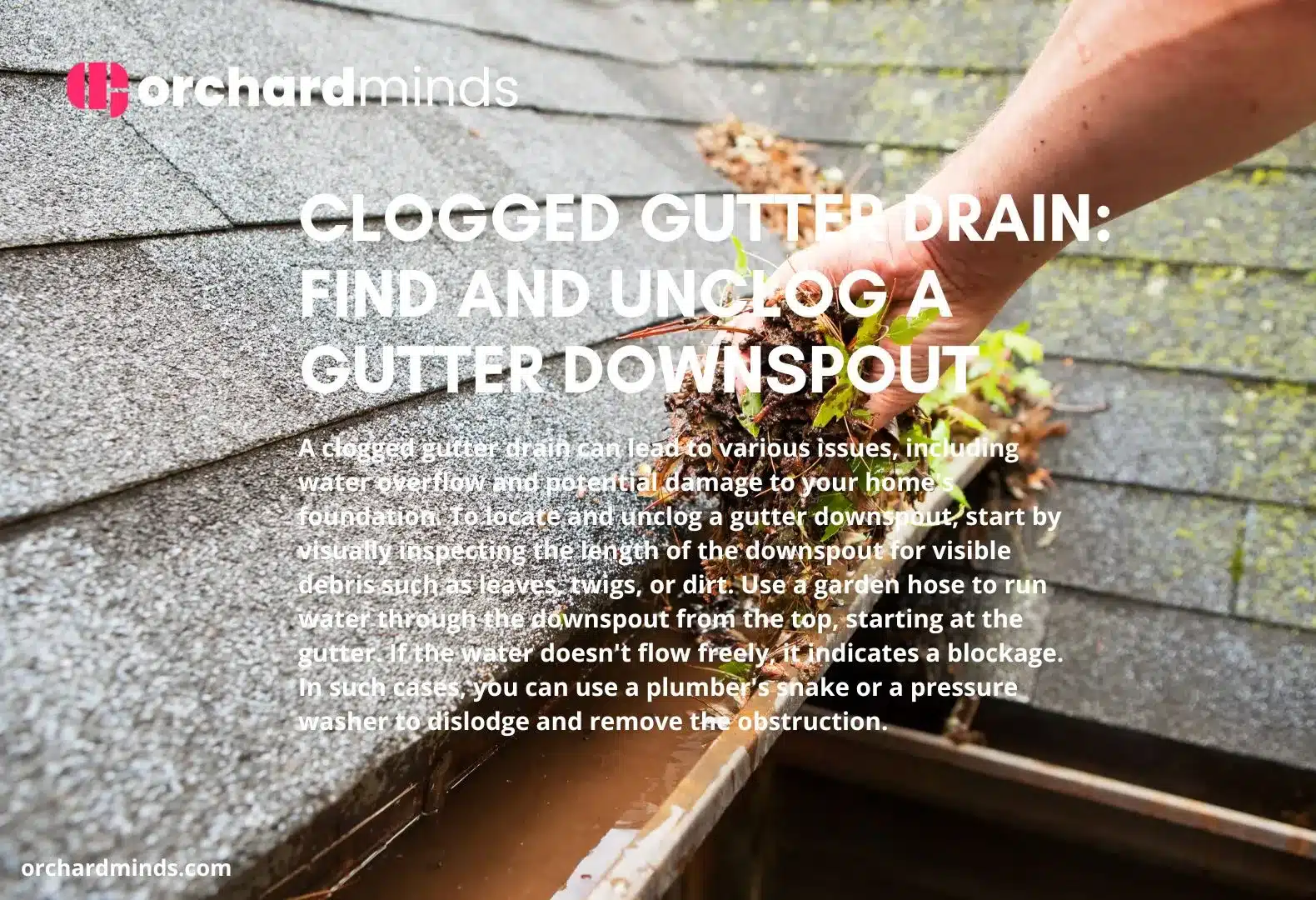A clogged gutter drain can lead to various issues, including water overflow and potential damage to your home’s foundation. To locate and unclog a gutter downspout, start by visually inspecting the length of the downspout for visible debris such as leaves, twigs, or dirt. Use a garden hose to run water through the downspout from the top, starting at the gutter. If the water doesn’t flow freely, it indicates a blockage. In such cases, you can use a plumber’s snake or a pressure washer to dislodge and remove the obstruction.
Another effective method is to disassemble the downspout sections and manually clear out the debris. Regular maintenance, such as installing gutter guards and cleaning gutters seasonally, can help prevent clogs and ensure proper water drainage. Addressing a clogged gutter drain promptly helps maintain the integrity of your gutter system. It prevents potential water damage to your home.
What is the clog in the gutter drain pipe?
A clog in a gutter drain pipe refers to an obstruction or blockage within the drainage system that prevents the smooth flow of water. Common culprits for these clogs include leaves, twigs, dirt, and other debris that accumulate over time in the gutters. When these materials accumulate and restrict the passage of water through the downspout, it can lead to water overflow, potential damage to the gutters, and even pose a risk of water-related issues to the home’s foundation.
Addressing a clog promptly is essential to maintaining the functionality of the gutter system and preventing water damage to the property. Regular inspection and cleaning of gutter drain pipes are key practices to minimize the risk of clogs and ensure proper water drainage.
Signs Your Gutter Drain is Clogged
Water Pooling or Overflowing from Downspout Connection
One clear sign that your gutter drain is clogged is the presence of water pooling or overflowing near the downspout connection. When debris blocks the downspout, rainwater is unable to flow freely through the drainage system, causing it to accumulate and spill over the sides of the downspout. Addressing this issue promptly is crucial to prevent potential water damage to the foundation and exterior of your home.
Gutters Overflowing
If you notice your gutters overflowing during or after rainfall, it’s a strong indication of a clogged gutter drain. The overflow occurs when water cannot move through the gutter system efficiently, often due to debris accumulation. Overflowing gutters can lead to water pooling around the foundation, causing structural issues over time. Regular gutter maintenance, including cleaning and debris removal, is essential to prevent this common problem.
Clogged Downspouts
Another telltale sign of a clogged gutter drain is a visibly clogged downspout. You may notice water trickling down the sides of the downspout or an absence of water flow altogether. This can result from debris buildup within the downspout, hindering the proper flow of rainwater. Cleaning the downspouts regularly and addressing clogs promptly will help maintain the functionality of your gutter system and prevent potential water-related damage to your home.
Problems Caused by Clogged Gutter Drains
Clogged gutter drains can lead to a host of problems that pose risks to both the structural integrity of a home and its surrounding landscape. One significant issue is water overflow, where blocked downspouts prevent rainwater from being efficiently directed away from the house. This overflow can lead to water pooling around the foundation, causing soil erosion and potentially compromising the stability of the structure. Additionally, clogged gutters can contribute to the formation of ice dams in colder climates, as trapped water freezes and expands, potentially damaging the roof and gutters. The excess weight of debris-laden gutters can also strain the fascia and soffit, leading to structural damage over time.
Moreover, the stagnant water in clogged gutters becomes a breeding ground for pests, such as mosquitoes. It can contribute to the growth of mould and mildew. Addressing clogged gutter drains promptly through regular maintenance is crucial in preventing these issues and preserving the overall health and durability of a home.
How to unclog the gutter drain pip?
With a Powered Drain Snake
Unclogging a gutter drain pipe with a powered drain snake is a straightforward yet effective method. Start by inserting the powered drain snake into the downspout from the top, working it gradually down the length of the pipe. The rotating drill at the end of the snake will help break up and dislodge any debris or blockages in its path. As you navigate the snake through the downspout, be attentive to resistance, as this may indicate the location of the clog.
Once the snake reaches the bottom, retract it slowly while running water through the downspout to flush out dislodged debris. This method is particularly useful for stubborn clogs. It provides a quick and efficient way to restore proper water flow in the gutter drain pipe. Always follow safety guidelines and manufacturer instructions when using powered equipment.
How to unclog underground gutter drain pipe
Downspout Strainer
To unclog an underground gutter drain pipe, consider using a downspout filter as a preventive measure and a tool for maintenance. Downspout filters are designed to catch debris before it enters the underground drainage system, minimizing the risk of clogs. If your underground drain is already clogged, you may need to access the end of the downspout and remove the strainer to manually clear debris. Additionally, consider using a plumber’s snake or a high-pressure water hose to dislodge and remove obstructions within the underground drain pipe. Regularly checking and cleaning the downspout strainer can help prevent clogs and ensure effective water drainage through the underground system, reducing the risk of water-related damage to your property.
Downspout Filter Box
To unclog an underground gutter drain pipe with a downspout filter box:
- Start by removing any debris or dirt covering the filter box.
- Open the box and inspect the filter for accumulated leaves and debris.
- Remove and clean the filter thoroughly.
- Use a plumbing snake or a high-pressure water hose to carefully insert into the downspout and break up any clogs within the underground pipe. If the clog persists, consider using a drill to navigate through the drain and dislodge the obstruction.
Regular maintenance of the downspout filter box and periodic checks for clogs can help prevent future blockages and ensure proper water flow through the underground gutter drain system.
Gutter Covers/Leaf Guards
To unclog an underground gutter drain pipe, one effective solution is to install gutter covers or leaf guards. These preventive measures act as a barrier, preventing leaves, debris, and other materials from entering and obstructing the underground drain pipe. Gutter covers and leaf guards are typically designed to allow water to flow through while blocking larger particles. This reduces the risk of clogs and minimizes the need for frequent maintenance.
Selecting the right type of gutter cover or leaf guard for your specific gutter system and local climate conditions can significantly contribute to keeping the underground drain pipes clear and functioning efficiently. Regular inspection and cleaning of these protective measures may still be necessary. Still, their installation can greatly reduce the likelihood of clogs in the underground gutter drain pipe, ensuring proper water drainage and preventing potential water damage to your property.
Frequently Asked Questions about Clogged Gutter Drain
What Tools Do I Need for Gutter and Downspout Cleaning?
For effective gutter and downspout cleaning, gather essential tools such as a sturdy ladder, work gloves, a garden trowel or scoop for debris removal, a bucket to collect the debris, a hose for flushing, and a plumber’s snake or pressure washer to clear clogs. Additionally, having a safety harness and protective eyewear is advisable when working at heights. These tools ensure a thorough cleaning process, removing debris and preventing potential clogs.
How Often Should I Clean Gutters and Downspouts?
The frequency of gutter and downspout cleaning depends on factors such as the surrounding vegetation and climate. In general, it’s recommended to clean gutters at least twice a year – once in the spring to remove debris accumulated during the winter and again in the fall to clear leaves before the winter season. However, homes with overhanging trees or in areas with heavy rainfall may require more frequent cleaning to prevent clogs and maintain optimal water flow.
How to Locate the Clog in Gutters
To locate a clog in your gutters, conduct a visual inspection and look for areas where water is overflowing or dripping. Use a hose to run water through the gutters, starting at the highest point, and observe the flow. The section where water accumulates or doesn’t flow smoothly likely indicates the location of the clog. Alternatively, you can use a plumber’s snake or an auger to probe the downspouts and gutters until you encounter resistance, helping identify and address the obstruction.
Can Clogged Gutters Damage My Roof?
Yes, clogged gutters can cause damage to your roof. When gutters are obstructed, water can accumulate on the roof, leading to potential leaks, rotting of roofing materials, and even structural damage over time. Ice dams can also form in colder climates, causing further stress on the roof. Regular gutter cleaning is essential to prevent these issues and protect the integrity of your roof.
Can Clog Gutters Cause Ceiling Leaks?
Clogged gutters can indeed contribute to ceiling leaks. When gutters are unable to channel water away from the house due to clogs, rainwater can overflow and seep into the home’s foundation and walls. This water infiltration can result in ceiling leaks, water stains, and damage to interior surfaces. Keeping gutters clear and ensuring proper water drainage is crucial in preventing such leaks and maintaining the health of your home’s interior.



Leave a Comment